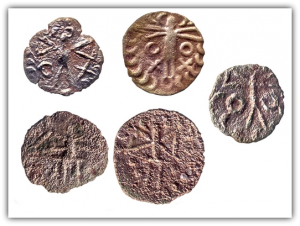Coins of the «unknown People»

In the middle of the last century the scientists drew their attention to the presence among the numismatic materials of Eastern Europe and the Caucasus of ancient times “barbarous” imitations of Roman coins: the summary A. Oreshnikov (1892) coin types with the image marching Mars, widely spread mainly on the Asian side of the Bosporus and in the adjacent areas of the North Caucasus, they had already existed under this riddle name. Since then they along with other findings of “barbarous” imitations of Roman coins, and entered all the major numismatic summaries of the Black Sea for the ancient era. Perhaps the most complete collection of the coins for this group have been described in the A.N. Zograf “spreading of finds of ancient coins in the Caucasus”, in which they have been identified as barbaric imitation to Roman imperial dinarius depicting figures of marching Mars, which appears on the Roman Republican coins. The most likely prototype, according to the researcher, was the denarius of Marcus Aurelius (161‒180 years).
A.N. Zograf spoke about gradual degradation of both in style and in metal (silver downed to a virtually pure copper) and it allowed by L.N. Kazamanova and V.V. Kropotkin to divide into them three chronological groups.
The obverse of the coin of the «unknown people» had an image of curly bearded head, apparently the Emperor Marcus Aurelius. On the rough imitations the lush hair turns into the points and radial diverging laterally wavy lines or arc-shaped bars. The coin’s reverse was marked by a schematic representation of human figure: Mars marching to the right or a warrior with a spear. In most of the very used coins the corps was depicted as a triangle crossed by the line.
A comparison of coin types allowed to find out that they were imitating Roman coins with the image of the Roman deity of war Mars with spear at the ready.
Of particular interest are the second most numerous coins of the second chronological groups. They are made of low-grade silver and consist of many series with different trims.
The most contentious issue, but nevertheless the most important to determine the historical place of this group of coins is their absolute chronology. Unfortunately, the findings of these coins in the “closed” (dated exactly) in the archaeological complexes had not been testomanied. The terminus post quem, in general opinion gives prototypes of coins dating ‒ denariis of Marcus Aurelius, which, according to V.V. Kropotkin, were in circulation in the territory of Eastern Europe before the beginning of the third century BC.
The coins of the most early group, as rightly pointed by D.B. Shelov appear during mass penetration of their prototypes – a the end of the second or at the beginning of the third century of AD. The gavel of the latest group gavel also fits into the limits of the third century AD. A long circulation of coins of the «unknown people» is proved by finds of coins of this type in the burials of the chronological group of the early burial Durso (not earlier than the second half of the 5th century AD.).
A number of researchers have noted that the circulation of these coins is clearly linked with the western regions of the North Caucasus. Moreover, their findings are clearly related to the region between modern Novorossiysk (the ancient Bata-harbor) and Anapa (Gorgippia): there they found 3 of 4 identified hoards consisting solely of coins of that type. It is important that among the discoveries in this area are mainly the second group coins. This group is the most numerous, and that can be confirmed by a long duration of its coinage.
This practice is known in other regions, which is an eloquent testimony of the active development of state institutions under the direct impact of the ancient influence.
It is important that, despite the emergence of imitation to the coins of Bosporus state the coins, as a prototype of Roman coins had been, widely used were. On can think that this fact is not a blind following of the fashion, but a purely political measure of the political structure, which belonged to the gavel. Despite the obvious trend of coin finds to the territory of the Asian Bosporus, the choice as a prototype of the coins of the powerful, but distant Rome rather than the nearby Bosporus is an evidence of an effort to emphasize the political independence and perhaps even equality: an equal ally of Rome. Attention is drawn to the significance of the finds of the Roman coins of emperor Neron (1th century) and Antoninus Pius, Marcus Aurelius, Commodus, and Lucius Verus (2th century).
The concentration of finds indicates that this state formation had developed in the south-eastern periphery of the Bosporian kingdom in the first half of the third century AD. The spread of the individual findings on the Taman’ Peninsula (Asian Bosporus) shows the peaceful relations, and perhaps even the circulation of these coins in the Asian Bosporus. Moreover, the territory in which the maximum number of the found coins of this type could be for some time a united political and economic space.
On the other hand, the spreading of coins to the most remote areas of the North Caucasus indicates that the creation of the political state involved the political elite of the North Caucasus tribes as D.B. Shelov believed of the Sarmatian-Alan group.
An interest to these coins is big due to the fact that they had been found in the late and early medieval complexes, thus at the contact of the two epochs. They have a symbol of the time, as if symbolizing the gradual extinction of ancient traditions in this region.
(Aleksey A. Malyshev)
